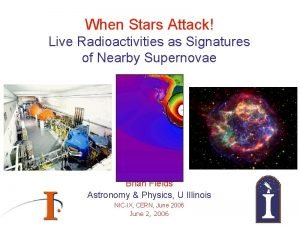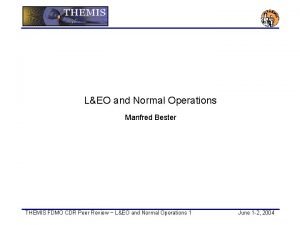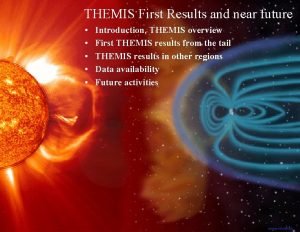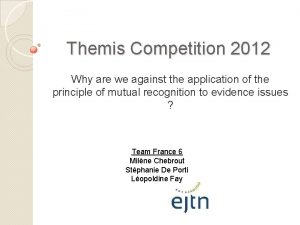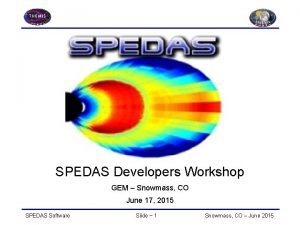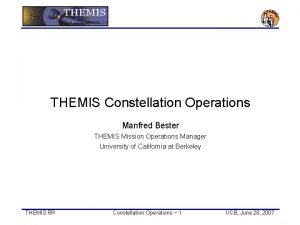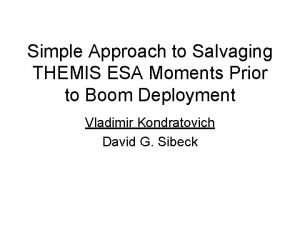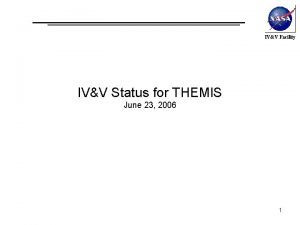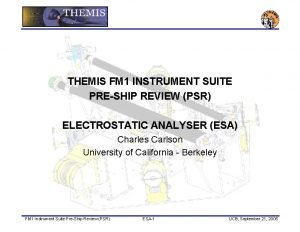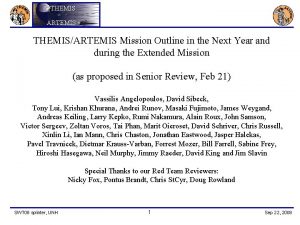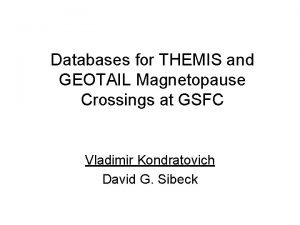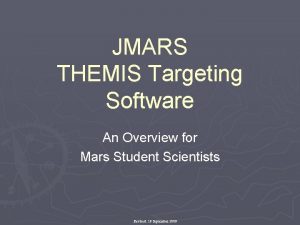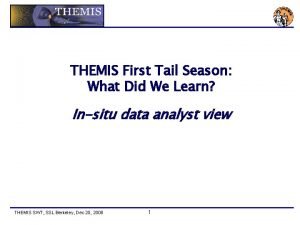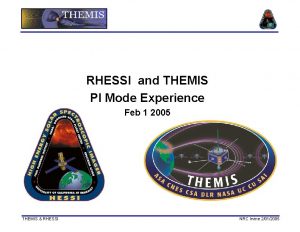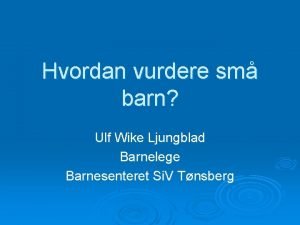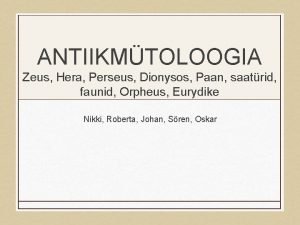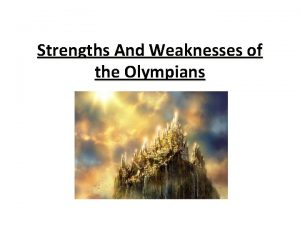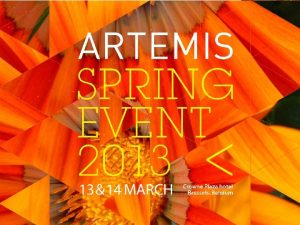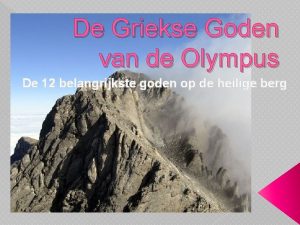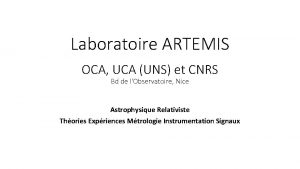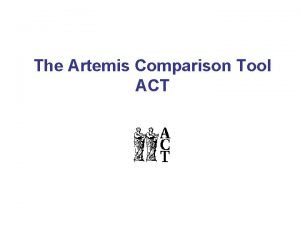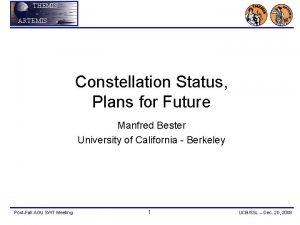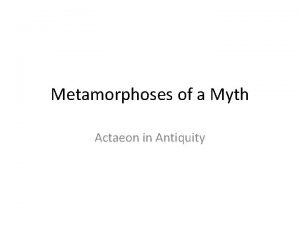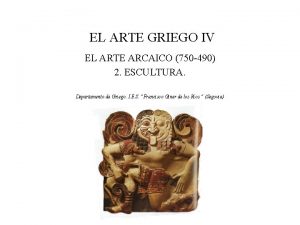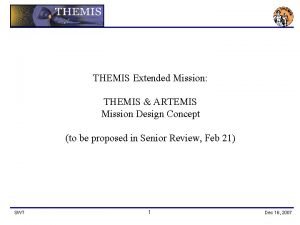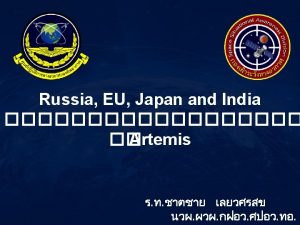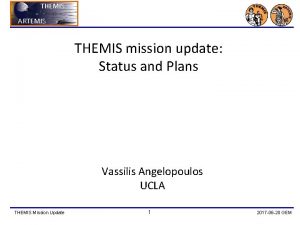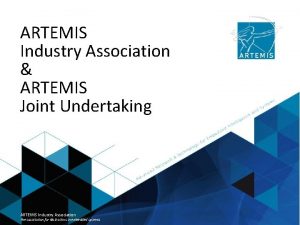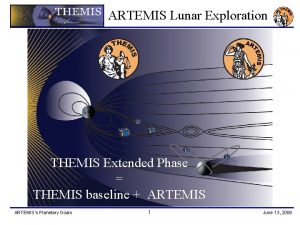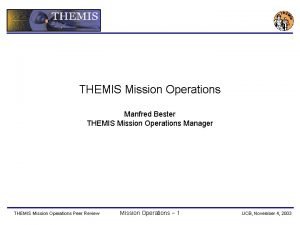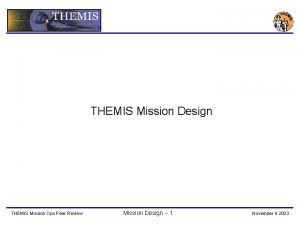THEMIS ARTEMIS THEMISARTEMIS Mission Outline in the Next
































- Slides: 32

THEMIS ARTEMIS THEMIS/ARTEMIS Mission Outline in the Next Year and during the Extended Mission (as proposed in Senior Review, Feb 21) Vassilis Angelopoulos, David Sibeck, Tony Lui, Krishan Khurana, Andrei Runov, Masaki Fujimoto, James Weygand, Andreas Keiling, Larry Kepko, Rumi Nakamura, Alain Roux, John Samson, Victor Sergeev, Zoltan Voros, Tai Phan, Marit Oieroset, David Schriver, Chris Russell, Xinlin Li, Ian Mann, Chris Chaston, Jonathan Eastwood, Jasper Halekas, Pavel Travnicek, Dietmar Krauss-Varban, Forrest Mozer, Bill Farrell, Sabine Frey, Hiroshi Hasegawa, Neil Murphy, Jimmy Raeder, David King and Jim Slavin Special Thanks to our Red Team Reviewers: Nicky Fox, Pontus Brandt, Chris St. Cyr, Doug Rowland SWT 08 splinter, UNH 1 Sep 22, 2008

THEMIS ARTEMIS Mission Planning Status • THEMIS approved as proposed in FY 10 -12 – – With a ~1/3 science budget reduction Three probes in inner orbits Performs Cluster-type science in region not visited by Cluster Detailed planning commences today (now that Tail 2 is in check) • ARTEMIS program approved – Funding for operations only, minimal for science team • Heliophysics ARTEMIS GI program (1 M/yr x 2 yrs), team can compete for – Requested help from the Planetary Division, first installment received • Expect to submit proposal to Planetary by mid-November for more funds • Costs to defray Ops costs, releasing funds for Heliophysics science – Will enable co. I funds for 8 new scientists • A Participating Scientist Program to be bundled with GI (1 M/yr x 3 yrs ? ) • Reviews – Planetary proposal: Mid-November – ARTEMIS Operations Review: December 2008 – Confirmation review: February 2009 SWT 08 splinter, UNH 2 Sep 22, 2008

THEMIS ARTEMIS SWT 08 splinter, UNH Mission at a Glance (SR 2008 -Tbl. 1 A) 3 Sep 22, 2008

THEMIS ARTEMIS Next (Dawn) Sector Conjunctions • Radiation Belt science triggers were limited before, now can improve – Density trigger works great at M-pause but not in Rad. Belts – Considering waves trigger: FB from SCM, 80 Hz – 1 k. Hz band • Radiation Belt Fast Survey increases – Increase duration to 2 hrs on either side of Rad. Belts (outside L=4) • Mode changes: – Worth going to higher frequency (16 k. S/s) and closer (maybe in dusk sector? ) • Planning starts week of Sept. 30 th – Maneuvers on week of Oct 6 th – Rad. Belt new modes proposed to be implemented on week of Oct. 13 th SWT 08 splinter, UNH 4 Sep 22, 2008

THEMIS Next (Tail) Season Conjunctions ARTEMIS • Learning our lessons from past tail season: – P 1, P 2 saw tailward flows/beams only when <1 RE – P 1, P 2 saw no dispersed energetic particle beams when >1 RE • Only a handful of events (Feb. 16 to Mar. 1) amenable to timing – Yield loss within +/- 1 RE due to plasma sheet flapping: <40% – Need to be near neutral sheet (d. NS <1 RE) to improve substorm statistics. 1 st tail season (Jan-Mar 2008) Feb-10 Feb-14 Feb-26 Mar-01 Feb-18 Feb-22 Jan-29 Feb-2 Feb-6 Jan-29 Midnight SWT 08 splinter, UNH Pre-midnight 5 Sep 22, 2008

P 3, 4, 5, orbits for T 3/D 3/R 3 THEMIS Separations >0. 5 RE in d. R-d. Z ARTEMIS T 3 (2010 -04 -05) D 3 (2010 -11 -01) Y P 3 Z P 5 P 4 P 5 Y X P 3 D 3, GSE coord’s View from dawn on Ecliptic d. Z(P 3 -P 5) ~ 1000 -3000 km d. R(P 3 -P 4)~1000 km < d. Z [every day] Apogee~12 Re T 3, GSE coord’s View from dawn along NS d. Z(P 3 -P 5) ~ 600 -3000 km d. R(P 3 -P 4)~1 RE > d. Z [every 8 days] Y R 3 (Year-round) X Z P 5 P 4 P 3 R 3, GSE coord’s View from top d. Z(P 3 -P 5), as in T 3. Variable along-track separations SWT 08 splinter, UNH 6 Sep 22, 2008

P 3, 4, 5 orbits for T 4, D 4, R 4, T 5 THEMIS Separations < 0. 5 RE in d. R-d. Z ARTEMIS T 4 (2011 -05 -10) Z T 5 (2012 -06 -21) Z D 4 (2011 -12 -01) 1000 km Y Y T 4 (and T 5), GSE coord’s View from dawn along NS d. Z(P 3 -P 5) ~ 100 -500 km d. R(P 3 -P 4)~1000 km > d. Z [every day] Apogee ~ 12 R E X D 4, GSE coord’s d. Z(P 3 -P 5) ~ 1000 -3000 km d. R(P 3 -P 4)~1000 km < d. Z [every day] Apogee~12 Re X R 4 (at Dawn/dusk) P 5 P 4 P 3 R 4, GSE coord’s View from top String-of-Pearls. Variable along-track separations: 100 km-2 RE SWT 08 splinter, UNH 7 Sep 22, 2008

THEMIS ARTEMIS SWT 08 splinter, UNH P 3, 4, 5 prime maneuvers and delta. V 8 Sep 22, 2008

THEMIS Extended THEMIS Baseline (P 3, P 4, P 5) ARTEMIS • At the Magnetotail, Study: • With first ever: – Nature of the near-Earth current sheet – Dissipation of bursty fast flows – Simultaneous d. R-d. Z separations, 0. 1 -1 RE – Clustered orbits study the 8 -12 RE region • Result: – Ability to map and model key instability region 2010 -04 -10 00: 00 Z FAST P 4 P 3 X X P 5 Y Courtesy: Pulkkinen and Wiltberger SWT 08 splinter, UNH 9 Sep 22, 2008

THEMIS ARTEMIS Extended THEMIS Baseline (P 3, P 4, P 5) • At Inner Magnetosphere, Study Role of: – ULF/VLF/EMIC waves on ion, electron energization/losses – Large electric fields on storm time ring current • Using novel: – 0. 1 -2 RE separations to resolve temporal/spatial evolution of gradients – daily conjunctions: PFISR, S-DARN • Result: – Comprehensive AC waves and E-fields models P 3 P 4 P 5 SWT 08 splinter, UNH 10 Sep 22, 2008

THEMIS ARTEMIS Extended THEMIS Baseline (P 3, P 4, P 5) • At Subsolar Magnetopause, study: • Using novel: – Asymmetric reconnection: dynamics, evolution and role of cold ions – Internal FTE structure and electron acceleration • Result: – Simultaneous d. R-d. Z separations at 0. 1 -0. 5 RE monitor inflow and outflow – Cluster-like separations at subsolar region – Hall-physics of subsolar magneto-pause reconnection, paves way to MMS 2010 -04 -10 00: 00 Z P 4 P 5 SWT 08 splinter, UNH P 3 [THEMIS Coast Phase Mozer et al. GRL 2008] X 11 Sep 22, 2008

THEMIS ARTEMIS SWT 08 splinter, UNH THEMIS Extension (FY 10, 11, 12) 12 Sep 22, 2008

THEMIS ARTEMIS Translunar injection in September 2009 Take what you can for 2 nd dayside science during orbit raise (loss minimal) SWT 08 splinter, UNH P 1 raise starts Aug 1, 2009 P 2 raise starts July 1, 2009 Phase I (Oct ’ 09 – Oct ’ 10) - placement P 2 P 1 13 Sep 22, 2008

THEMIS ARTEMIS Selective Orbits Phase II (Oct ’ 10 – Jan ’ 11) – opposite SWT 08 splinter, UNH 14 Sep 22, 2008

THEMIS ARTEMIS Selective Orbits Phase II (Oct ’ 10 – Jan ’ 11) – opposite SWT 08 splinter, UNH 15 Sep 22, 2008

THEMIS ARTEMIS Selective Orbits Phase III (Jan ’ 11 – Apr ’ 11) – same side SWT 08 splinter, UNH 16 Sep 22, 2008

THEMIS ARTEMIS Phase III (Jan ’ 11 – Apr ’ 11) – same side SWT 08 splinter, UNH 17 Sep 22, 2008

THEMIS ARTEMIS Phase III (Jan ’ 11 – Apr ’ 11) – same side SWT 08 splinter, UNH 18 Sep 22, 2008

THEMIS ARTEMIS SWT 08 splinter, UNH ARTEMIS Wake Crossings: Phase II, III 19 Sep 22, 2008

THEMIS ARTEMIS Distant Wake Crossings: A Perspective d. B SWT 08 splinter, UNH 20 Sep 22, 2008

THEMIS ARTEMIS SWT 08 splinter, UNH Phase IV (Apr ’ 11 – Sep ’ 12) ARTEMIS After Insertion 21 Sep 22, 2008

THEMIS ARTEMIS SWT 08 splinter, UNH ARTEMIS Wake Crossings 22 Sep 22, 2008

THEMIS ARTEMIS SWT 08 splinter, UNH ARTEMIS Fuel Margin 23 Sep 22, 2008

THEMIS ARTEMIS Tail Science (P 1, P 2) • In the Magnetosphere, study: • Using the first: – Particle acceleration: X-line or O-line? – Reconnection: 3 D character and global effects – Turbulence: Drivers and effects – Two point: d. X, d. Y measurements – …at scales from ion gyroradius to several RE • Result: – Reveal 3 D distant tail, dynamics • In conjunction with: – Solar wind monitors: • ACE, WIND, STEREO – Inner magnetosphere monitors: • Cluster, Geotail, FAST SWT 08 splinter, UNH 24 Sep 22, 2008

THEMIS ARTEMIS Solar Wind Science (P 1, P 2) • In the Solar Wind, study: • Using first of a kind: – Particle acceleration at shocks – Nature and extent of elusive low-shear reconnection – Properties of inertial range of turbulence • Result: – …two point measurements at scales 1 -10 RE, ideal for study of particle evolution in shocks, at foreshock and inertial range of turbulence – Advance our understanding of particle acceleration and turbulence in Heliosphere • In conjunction with: – Other solar wind monitors: • ACE, WIND, STEREO • ARTEMIS is: – High-fidelity solar wind monitor – In beacon mode if requested SWT 08 splinter, UNH 25 Sep 22, 2008

THEMIS ARTEMIS Wake Science (P 1, P 2) • At the Moon/Wake: • Using first of a kind: – Study 3 D structure and evolution of wake – …two point measurements at scales 0. 1 -10 RE, ideal for two– Understand particle acceleration processes at wake point correlations within wake and – Understand wake refilling for various SW conditions between wake and solar wind • Result: – Advance our understanding of wakes at planetary moons, plasma void refilling around large objects (Shuttle, ISS, Hubble) SWT 08 splinter, UNH 26 Sep 22, 2008

THEMIS ARTEMIS Planetary Science (P 1, P 2) • Apollo observers saw dust elevated above the lunar surface to possibly high altitudes. • LADEE will probably have a dust detector, but has no capability of measuring the solar wind electric and magnetic fields. • ARTEMIS measures the solar wind velocity, the interplanetary magnetic field and hence the solar wind electric field. It also can measure surface potentials with electron reflectometry. • ARTEMIS plus LADEE will enable us to determine the response of charged lunar dust to the lunar and solar wind electric fields. Dust Levitation in Electric Fields LADEE ARTEMIS-1 ARTEMIS-2 SWT 08 splinter, UNH 27 Sep 22, 272008

THEMIS ARTEMIS • ARTEMIS and Lunar Exosphere Apollo’s ALSEP package contained a suprathermal ion detector (SIDE) that detected ions accelerated by electric field toward lunar surface. WIND observations confirmed presence of heavy ions around moon. • Temporal history of ion fluxes on SIDE suggested that the moon might be episodically outgassing. Alpha particle observations of localized concentrations of radon also support this viewpoint. • This observation needs confirmation. If true, there may be a source of lunar volatiles at low latitudes, not just at the poles. • ARTEMIS has an ion detector and measures the solar wind electric field so it can test the SIDE hypothesis of an outgassing moon. Exospheric Pickup Ion ARTEMIS mass spectrometry of pickup ions assumed “protons” V , y H+ He+ Solar Wind V , x H 2 O+ S+ ARTEMIS-2 ARTEMIS-1 Hartle et al. , 2005 SWT 08 splinter, UNH 28 Sep 22, 2008

THEMIS ARTEMIS and Lunar Surface • Lunar Surface: • Using first of kind: – Study composition and distribution of sputtered ions – Understand crustal magnetic fields, surface charging – Remotely sense surface properties of lunar regolith • Result: – …two point measurements of ions and electrons near the Moon, with unprecedented energy coverage and resolution; beyond LP electron reflectometry capability – Advance our understanding of fundamental plasma interactions with planetary surfaces. Secondary electrons measured by Lunar Prospector [Halekas et al. 2008] Trace sputtered ions back to lunar surface ARTEMIS Secondary and photo-electrons accelerated from charged lunar surface reveal regolith surface properties SWT 08 splinter, UNH 29 Sep 22, 2008

THEMIS Interior Structure of the Moon ARTEMIS P 1 P 2 Core? • • Apollo orbital measurements provided evidence of an iron core of about 400 km radius. Lunar Prospector made similar (single instrument) measurements and confirmed the Apollo subsatellite result. Two-point measurements are needed to go beyond the current two-layer model of the interior electrical conductivity. ARTEMIS will provide measurements of both the “exciting” field and the resulting induced magnetic field at about 100 km over a range of frequencies and sound the electrical conductivity profile above the core. SWT 08 splinter, UNH 30 Sep 22, 302008

THEMIS ARTEMIS and Planetary, Summary • In support of LRO: – ARTEMIS can provide comprehensive monitoring of Lunar Space Environment – Complements LRO/CRATER providing measurements below 6 Me. V • Note: ARTEMIS has been already supporting LRO via White Sands G/N testing • Supports NAS’s Scientific Content of Exploration of the Moon to: – Understand the lunar atmosphere • In support of all missions – ARTEMIS provides comprehensive monitoring of plasma conditions and lunar surface electric fields – Allows study of the response of the lunar exosphere and dust to external drivers – ARTEMIS provides solar wind monitoring SWT 08 splinter, UNH 31 Sep 22, 2008

THEMIS ARTEMIS THEMIS/ARTEMIS Outlook Senior review to finalize FY 11 -12 budget expected in 1. 5 yrs (due Feb 10), based on team publications. Opportunities for extended mission beyond 2012 are good but the level depends solely on the team’s productivity and the quality of research from the prime mission and the first extension ! SWT 08 splinter, UNH 32 Sep 22, 2008
 X.next = x.next.next
X.next = x.next.next Themis athanassiadou
Themis athanassiadou Themis
Themis Themis dc
Themis dc Themis
Themis Themis lenguaje inclusivo
Themis lenguaje inclusivo Themis competition
Themis competition Spedas wiki
Spedas wiki Katrina connors
Katrina connors Themis constellation
Themis constellation Themis athanassiadou
Themis athanassiadou Esa themis
Esa themis Themis
Themis Themis fm
Themis fm Artemis
Artemis Themis
Themis Themis software
Themis software Themis
Themis Themis pi
Themis pi Temple of artemis
Temple of artemis Hms artemis
Hms artemis Vanakreeka muistendid ja pärimused
Vanakreeka muistendid ja pärimused Juno roman goddess
Juno roman goddess Hera weaknesses
Hera weaknesses Artemis industry association
Artemis industry association Griekse goden attributen
Griekse goden attributen Artemis oca
Artemis oca Artemis
Artemis Chrl3
Chrl3 The fates symbol
The fates symbol Artemis constellation
Artemis constellation Artemis slaying actaeon
Artemis slaying actaeon Acropoli
Acropoli

